#casino royale: a james bond novel
Text
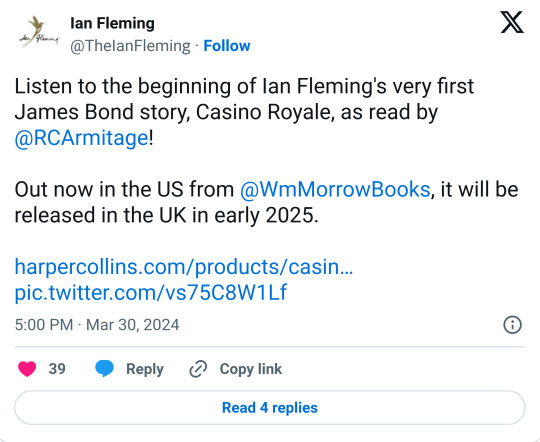
#richard armitage#ian fleming#casino royale: a james bond novel#james bond#007#new audiobook#audiobook#post#tweet#twitter#twitter x#x#news
23 notes
·
View notes
Text
Kinda thought Paul was joking about the Barry Nelson thing (especially with Angus reacting like that), but he was actually right, because...
:O
#might as well watch this#after already watching casino royale 1967 & casino royale 2006 & starting the original novel lol#hignfy#james bond
3 notes
·
View notes
Text
Happy Casino Royale Publication Day!
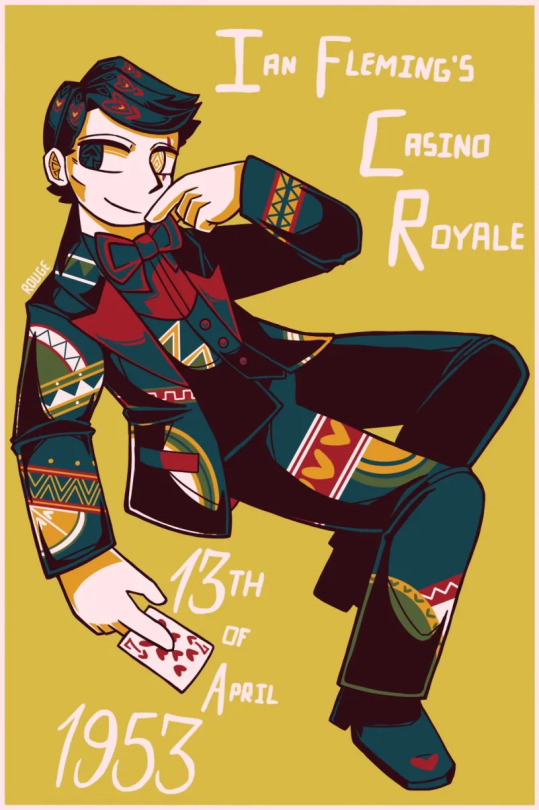
[ID in alt text]
#james bond#007#le chiffre#casino royale#my art#(can't believe it's been 71 years since the original novel got published but there he is!! le chiffre!!)
5 notes
·
View notes
Text

#james bond#007#ian fleming#casino royale#books#novels#quotes#vodka martini#drinks#beverages#ingredients#1950s
7 notes
·
View notes
Photo

Casino Royale
here’s a link to buy the book-https://www.amazon.co.uk/Casino-Royale-James-Bond-007/dp/0099576856/ref=sr_1_3?dchild=1&keywords=casino+royale&qid=1609088020&s=books&sr=1-3
0 notes
Text
JAMES BOND REFERENCES IN MORIARTY THE PATRIOT
I am a big fan of James Bond since my early teenage years. I watched every movies and read all books, so when the Moriarty the Patriot manga first started using James Bond references, I basically screamed. And my voice got 100x louder when the iconic My name is Bond. James Bond. scene happened.
I always wanted to write an analysis of YuuMori's James Bond connections, so now here we are.

First, let's talk a bit about the actual James Bond universe. The character of James Bond - the MI6 agent numbered 007 with a license to kill - got created by Ian Fleming in 1953. He first appeared in the novel called Casino Royale. Fleming wrote 12 novels and two short story collections with the character. The novels soon got movie adaptations, too, the first James Bond movie was Dr. No in 1962, where Sean Connery played Bond. Currently there are 25 Bond movies.
The James Bond movies can be classified into eras by the actor who played Bond. In order, these follow:
Sean Connery
(George Lazenby - but everyone tends to pretend this movie never happened)
Roger Moore
Timothy Dalton
Pierce Brosnan
Daniel Craig
The movies didn't come out in chronological order when it comes to James Bond's life-happenings. Most movies can be watched as stand-alones - but the Daniel Craig era tried to built up a storyline, where the movies are tied to each other. The James Bond movies always have an iconic intro, sing by a popular singer of the current era (the last movie's intro song was by Billie Eilish.)
The James Bond movie universe started to fuse with the Sherlock Holmes universe thanks to the Alan Moore comic book series, The League of Extraordinary Gentleman (1999). Professor Moriarty appeared here as M - the title what later ended up with Mycroft. The Elementary series (and somewhat BBC Sherlock) continued this tendency, featuring Mycroft as someone who has ties to the MI5/MI6.

Professor Moriarty in TLoEG
The Moriarty the Patriot series features most characters who are important in James Bond movies. They are..
M - the leader of the MI6, which role was fullfilled by Albert and Louis.
Q - the inventor who keeps coming up with weapons and cars for James Bond. In YuuMori, Q is Von Herder, the blind mechanic mentioned in the Empty House Conan Doyle story.
Ms. Moneypenny - a secretary working personally for M. In the Daniel Craig era, she started as a field agent, but later moved to do office work. James Bond always gives her flowers and little souvenirs.
When it comes to James Bond, his personality in Moriarty the Patriot is similar to the canon one: loving good cars and guns, flirting with woman (especially Moneypenny) and while it's not vodka martini he orders in the pub when he met with Patterson, he asks for the drink shaken, not stirren. (On the other hand, the Macallan scotch he asks for is a reference to what James Bond drank in the Skyfall movie.)

The location of the MI6 in YuuMori is also similar to the James Bond movies: underground and underwater in the Thames.

The headquarter in Skyfall

The Q-sector
The Man with the Golden Army arc features other references for the James Bond universe. The arc's title refers to the movie/book The Man with the Golden Gun (Roger Moore-era) - the two stories only similarity is that both deal with special guns. In that arc, Sebastian Moran takes on the identity of the 006, Alec Trevelyan. The character originally appeared in the Goldeneye James Bond movie (Pierce Brosnan-era) played by Sean Bean. He had the number 006 and he was the mentor of James Bond (like Moran later on). He seemingly got killed off at the start of the movie (but later returned as a villain).

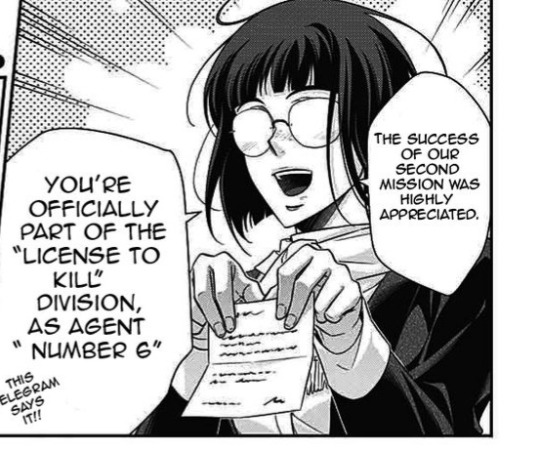

Alec Trevelyan in Goldeneye
Maybe not an intentional reference, but still interesting: the James Bond movie Tomorrow Never Dies features an evil media mogul, Elliot Carver as a villain who likes orchestrating catastrophic incidents so his newspaper can be the first to write about them, manipulating people that way and gaining control in the media - kind of similar to Milverton (yes, the media mogul Milverton thing is from Sherlock, but still), who was the mastermind behind the Jack the Ripper murders then manipulated the public through the news he created. (I can actually see him orchestrating incidents in order to gain more power and become the King of Media, too.)
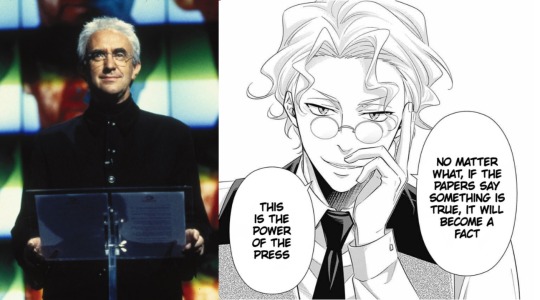
Elliot Carver in Tomorrow Never Dies
We've yet to see the main villain of James Bond: Ernst Stavro Blofeld, (first appearing in the Thunderball book) the head of the crime organization called Spectre. I wander when he will appear in YuuMori, if they appear at all, but I really wish!
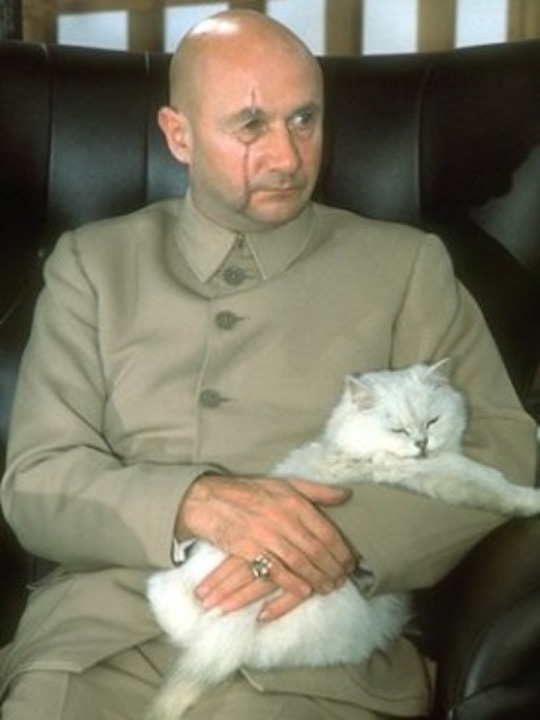
I hope in the next stories YuuMori's James Bond world keeps expanding - that's such an interesting aspect of the series, I love to see more references!
#moriarty the patriot#yuukoku no moriarty#james bond#ynm james bond#ynm sebastian moran#moneypenny#charles augustus milverton#more james bond references pls
76 notes
·
View notes
Photo
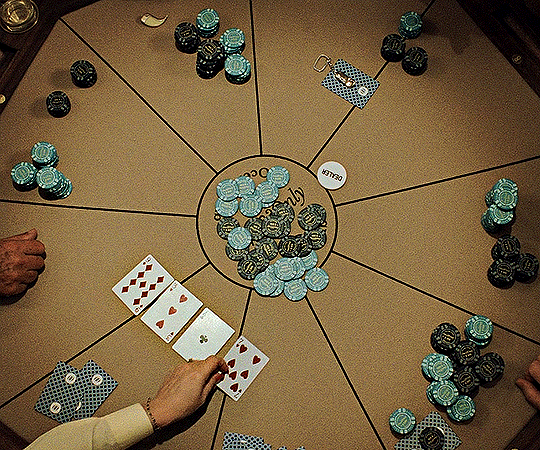






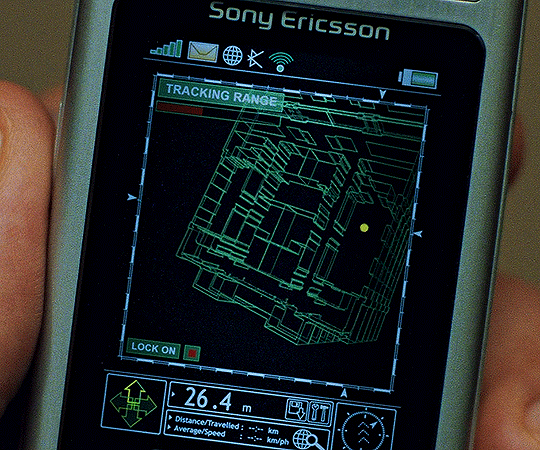
‘My name’s Felix Leiter,’ said the American. ‘Glad to meet you.’ ‘Mine’s Bond — James Bond.’
CASINO ROYALE (2006)
dir. Martin Campbell, adapted from the novel Casino Royale by Ian Fleming
#filmgifs#moviegifs#fyeahmovies#cinemapix#userstream#userbbelcher#chewieblog#userfilm#userbells#usersamanne#userclayy#userkraina#userteri#underbetelgeuse#userkd#casino royale#author: ian fleming#ours#by airam
696 notes
·
View notes
Text


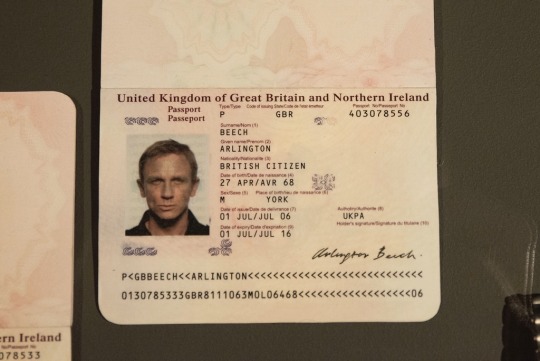


James Bond’s passports. Obviously the aliases have different birth dates, but it’s interesting to me that, in those that actually call him James Bond, one lists his birthday as 13th April, the date ‘Casino Royale’ was first released as a novel in 1953, and the other lists it as 11th November, the date given in ‘James Bond: The Authorized Biography of 007’.
#these aren’t my pics btw I stole them off google#enjoy my useless facts I looked this up instead of working#james bond#daniel craig#james bond 007#casino royale#skyfall
141 notes
·
View notes
Text
No doubt, most of you have heard the recent news of Quentin Tarantino deciding to shelve his planned-for-years movie, The Movie Critic, because he didn't think it was "worthy" of being his final film.
I can't say I was looking forward to it — absolutely nothing about the phrase "1970s period piece" is in any way appealing to me — but I find it to be just the latest example of something that's bugged me about QT for years: his tendency not to commit to ideas he has. I recall numerous occasions when Tarantino would bring up an ideas for movies he wants to make, and then never do anything with those ideas. Just a few examples of projects he's suggested but never followed through on:
A mob movie taking place in 1930s Australia
An "earth-bound" science fiction movie that "wouldn’t involve spaceships"
A biopic on abolitionist John Brown
A film adaptation of the novel Less Than Zero
A sequel to Kill Bill focusing on Elle Driver training Vernita Green's daughter to get revenge on The Bride
Before Casino Royale came out, he wanted to direct the next James Bond movie as a 1960s period piece but with Pierce Brosnan in the role one last time; no less a person than Sean Connery said it sounded like a cool idea
He also wanted to co-create a Star Trek movie with JJ Abrams
He also teased Killer Crow, a World War II-era Blaxploitation film about Black soldiers who make "a warpath to Switzerland" after being "fucked over by the American military
These all sound like amazing ideas for movies, and Tarantino is such a talented director that I have no doubt he could pull them off. Unfortunately, they'll never come to fruition because he's going to retire after his tenth movie to "preserve his artistic legacy" or whatever. I don't know why he feels like he has to do that; other directors like Spielberg and Scorsese are still cranking out hits well into their twilight years, so why does QT feel the need to limit himself?
And here's another question: if QT isn't going to direct those movies, can't he at least write the scripts and hand off directing duties to someone like Robert Rodriguez? From Dusk Till Dawn proved Rodriguez has what it takes to bring Tarantino's scripts to life; it could work with those other movies, too!
14 notes
·
View notes
Video
“He [Safin] offers the possibility to Bond to stay alive, but being unable to near the people he loves which is ultimately a checkmate of cosmic proportions.” - Academy-Award winning director Guillermo del Toro on the ending of “No Time to Die”
Appears my earlier post got a little bit of a reaction! Specifically, the bit in which “No Time to Die” cinematographer Linus Sandgren refers to Madeleine Swann as “the love of his life”. This provides a good opportunity to talk about on this platform what I think the logic is across the five-film CraigBond story and how Swann fits into this narrative.

“What are they burning?”
“Secrets, wishes, letting go of the past. Getting rid of the old, in comes the new.“
When we’re introduced to the character in “Casino Royale”, we see James Bond commit the first two kills that make him a 00. This doesn’t have its origins in the novels, so I think that number of two bears particular note. You can’t just kill one person, you have to kill two. Every time you hurt someone you are hurting two people: the other person, and you.
Now, there’s a through-line across all five movies — it is impossible to live a life if your life is killing people. We don’t need to look any further than the opening stanza to Chris Cornell’s “You know My Name”, the opening song to “Casino Royale”:
If you take a life do you know what you'll give?
Odds are you won't like what it is

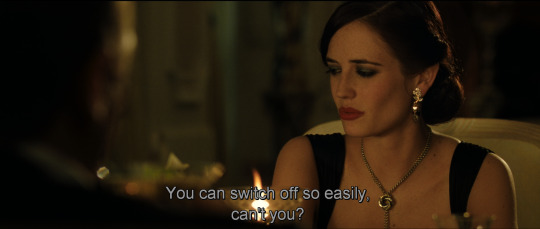


There are two people who exist: “James Bond” and “007″. One is a killer, one is not. Every time “007″ kills, it pushes “James Bond” further away from his humanity. I’m reminded of a line from “A Boy Like That” from “West Side Story” (A boy who kills cannot love/A boy who kills has no heart) that seems quite applicable to the character of James Bond, be it the literary or the film Bond. And the unfortunate curse of his profession is his licence to kill ends up being a double-edged sword. Or, as Dominic Greene says in “Quantum of Solace”:
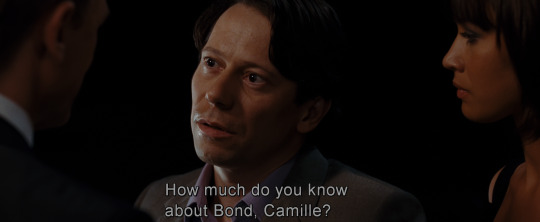
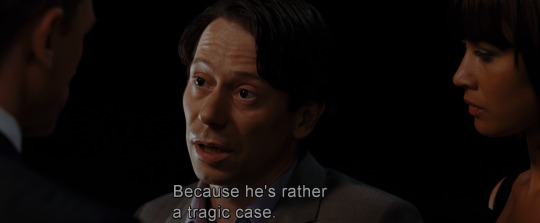


The tragedy at the core of “Casino Royale” is this fundamental divide within the character — if he holds onto his power over death, then everything he loves is doomed to die. James Bond’s identity is murder and death. But he yearns, so desperately, for connection. He is the Dangerous Lover fully. When he meets Vesper, he immediately falls for her and is willing to give up his everything for her but it is of no use. Vesper betrays him out of her own past attachment — honeypotted into a romance used to blackmail her — and she kills herself to spare Bond’s life. Yet, in pure irony, by saving Bond’s physical life she killed his humanity.
It is fitting in “Casino Royale” that the iconic line of the cinematic Bond (”Bond, James Bond”) doesn’t appear until right at the end of the film when Bond shoots the man responsible for the decision Vesper made. We are linking his identity to this act, that the choice Vesper made to save him drove him into being who we (the audience) know him as — a killer. His heart is sealed off when he uses that nasty, five-letter word in reference to Vesper.
If the ending of “Casino Royale” positions the character at his lowest — a totally heartless killer devoid of any humanity — then everything subsequent shows some kind of transformation out of that place. Drama is movement, after all. Stagnation is the enemy of functional storytelling.
“Quantum of Solace” features Bond wandering through the desert and restoring water to a thirsty people. The symbolism of this plot-beat is fairly straightforward — despite all his best intentions, there is a capacity for this killer to give life instead of just taking life. That bargain he made at the beginning of “Casino Royale” is not permanent (powers over death in exchange for your humanity/soul). He can emerge out of the desert and find rebirth. Transform into something new, restore what was lost.

The ending shot of “Quantum of Solace” — featuring Vesper’s jewel given to her by the honeypotter (is that word?) — is such a powerful image. It’s as if Bond is separating himself from his feeling, from his humanity. Committing to the life of a killer.


I have a whole thing about the use of silhouette in “Skyfall” and how Silva exists as a shadow-self of Bond’s anger towards M (which, I think, projects onto the death of his biological mother as every mythic hero has two sets of parents). Silva and Sévérine are a perverted mirror of Bond’s metatextual legacy, with the ending of the film arguing that there is something salvageable within this character with such a misogynistic legacy:
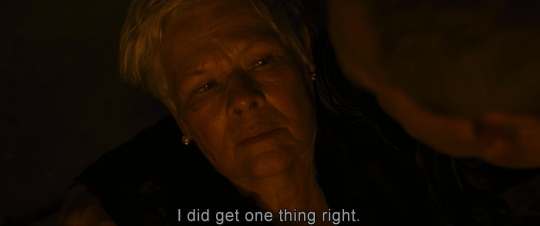
M, the surrogate mother, dies and gives Bond this last word — “I did get one thing right.” The goal of every parent, one imagines, is to not completely fuck up their child. M did fuck up Tiago Rodriquez (birthing Silva) but did not do the same to Bond. James Bond had every opportunity to end up like Tiago Rodriquez (literally “dying” and ending up with a clean slate to do whatever he wants with), but he returned when he found out MI6 (M, his “mother”) was in danger and worked to protect her. Because he loves her — despite sealing his heart off all those years ago, he still does love. That’s what she got right, maintain that humanity within Bond that so many others in this profession lose when they exist within death.


That man Bond shot at the end of “Casino Royale”, Mr. White, returns in “Spectre” — the key to Bond unraveling the mysterious organization that threatens global stability. Only this Mr. White is not the master assassin we last saw him as in “Quantum of Solace”, now he is frail and weak. Isolated. Mr. White abandoned the cause after the organization started targeting women and children, and now he waits for death to come for him as penance for what he has done in life. White recognizes how he and Bond are basically the same person — men who bring death upon the world, which ends up drawing distance between them and humanity at large.
But Mr. White has one thing keeping him alive:

Madeleine Swann is among the more fascinating characters in any popular, brand-name movie I’ve come across. The basic conceit of her character is “What if Death had a daughter, and she was the force of Life?”. She is a doctor who worked with international organizations that travel around the world healing people. This is, obviously, the equal opposite of Bond’s “licence to kill”. How could something so healing come from a man of total destruction? Mr. White is a particularly nasty guy, yet out from him emerged her. What a beautiful, hopeful message — the spark of life will always emerge no matter how bleak its circumstances are in existence.
“Spectre” shapes like a fairy tale: this dark knight (Bond) travels to the Pale King (Mr. White) thanks to a magical ring (the Spectre Ring), and the dying King tasks him to go save the Princess (Madeleine Swann) from the wizard who killed him. But the only way the knight can save the Princess is if he throws down his sword — because what really hurts her is killing. Or, as Swann says:

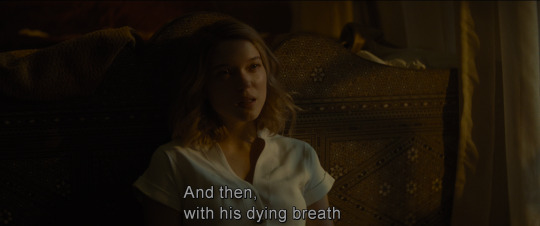

From the moment they meet, there is something different about Dr. Swann. She doesn’t just know Bond’s world — she *is* Bond’s world. She came from the same World of Death that he navigates in, yet emerged out of that a being of Life. A Doctor, the opposite of a Killer. Madeleine Swann serves as the total antithesis to the cruel belief Bond resigned himself to at the end of “Casino Royale” — life can emerge out of the underworld.
Going back to “Skyfall” for a moment, all of the stag imagery associated with Bond’s family in the film seems important — the stags antlers regrow each year. Out of the death of winter comes the rebirth of spring. New life from death

And there’s a line Silva tells Bond in his monologue where he talks about the psychological transformation MI6 makes agents go under through a parable of his childhood:
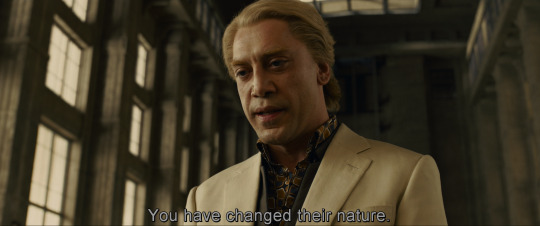
The default nature, “Skyfall” proposes, isn’t hurting but helping. We aren’t programmed to kill from birth, someone has to teach us to do that. Silva believes this is irreversible, but as we see through Bond’s journey in the film one can change their nature again back to a helper. Back to healing. Nothing is set in stone. The daughter of an assassin can become a force for life.

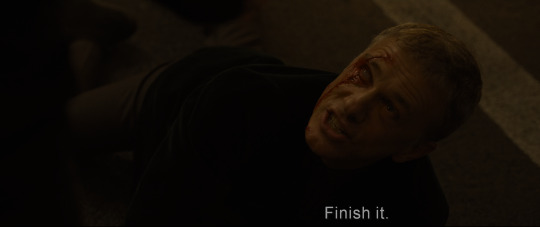

As the world’s biggest fan of “Spectre”, I’ll admit I was a bit concerned when I saw Daniel Craig was returning for one last Bond film and that Léa Seydoux was also coming back with him. I loved the ending of “Spectre” — the hero rejects the power of death (think the magical ending of “Return of the Jedi”) and embraces the love of life/life of love. He finds rebirth in this heart. His journey was complete! What more was there to tell?
Ha. Haha. Hahaha...
The trick about “No Time to Die”, dramatically, is it as much the story of Madeleine Swann is the story of James Bond. But more than anything, it is a meta-analysis of James Bond.
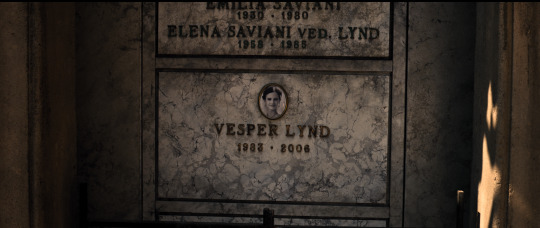
In “No Time to Die”, we return to Vesper’s grave (a beat taken from the novel “On Her Majesty’s Secret Service”, to the silly people I’ve seen on the MI6 forums or Reddit argue that the literary character wouldn’t do this).Vesper represents all of the death associated with Bond, and Swann tasks him to go to her grave to “let go”. They cannot have a future together if he cannot let go of his past. His past of killing will deny them a future. For Swann harbors a secret...
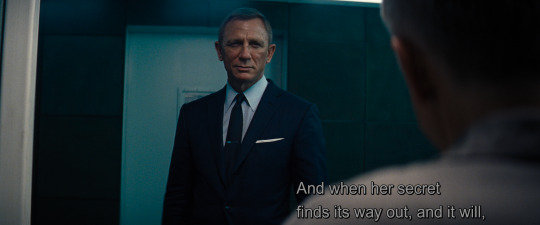

When Del Toro refers to the ending of “No Time to Die” as a cosmic checkmate, this is what he means — the base cosmological forces of life and death are in Bond’s hands, and he gets to choose which will emerge victorious. All of these films have featured him journeying to regain the humanity he lost in “Casino Royale”, the soul he loses every time he pulls the trigger of his Walther PPK. But the choice of him isn’t to throw down the weapon, the choice is for him to make the same choice M made in “Skyfall” or Vesper made in “Casino Royale” — die for love.
Madeleine Swann, as someone born of this same dark world of death, is the only one equipped to handle the psychological weight of James Bond — because they have this same pain. The first pre-title sequence of “No Time to Die”, where we see Madeleine’s mother (or Mr. White’s lover) die like the archetypal “Bond Girl” dies, grounds this in such a harrowing way. Both have seen their lives dramatically altered by betrayal of those who they loved, and because of this is betrayal it reduced the possibility of them finding restoration.


Broken in the same way. Fitting together perfectly because of it. Isn’t that love? She is life coming from death, and he is death coming from life. Equal opposites that form a perfect circle.
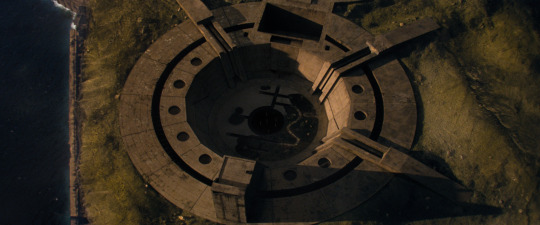
The inescapable irony of human existence is our attachments power us to exist but they also give us so much distress. A melted heart (good) and a broken heart (bad) are both destructive. Or, as Léa Seydoux (Madeleine Swann) described it in the marketing for “No Time to Die” — love is the promise of suffering. The love potion is the poison. That which save, kills. That which kills, saves.
At the end of “No Time to Die”, Bond could walk away and live with the knowledge that he would one day kill Madeleine Swann. His touch would one day kill her. But instead, he chooses death. He becomes a mortal man through love. He gives up everything for her. He dies *into* the relationship. As Deborah Lutz writes in “The Dangerous Lover” (40):
“The poignancy of love in romance comes from the sense that, once the full presence of love arrives, the characters will be gone; they will die in their narrative; there will be nothing left to say. Love becomes a fantasy of dying, a liebestod”.
The plotting of “No Time to Die” involves nanobots that kills on contact. Basically, it is literalizing that metaphor from “Quantum of Solace” — a literal Midas touch of death. What’s the only way for Bond to get out of this situation when he is poisoned with something that can kill the only person he loves? Let go. The only way he can have a future is if he lets go.
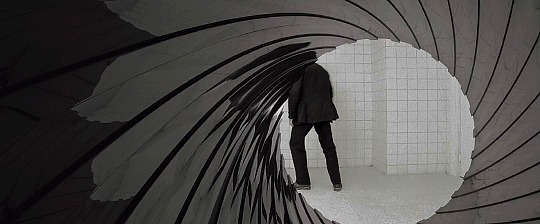

This is the magic of “No Time to Die”, and by extension the character of Madeleine Swann — cinema’s most famous killer has been transformed through her love into a life creator. The bleeding gun barrel has turned into one of light. The iconic line of the character has turned into something else entirely. Not the calling card of a killer it was in “Casino Royale”, but one of a life-giver.
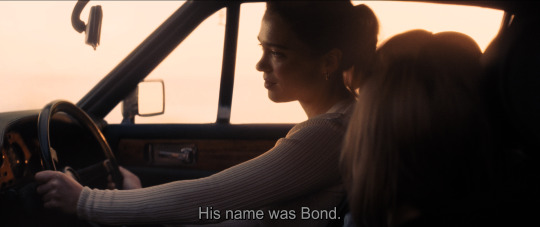

Because much as this being of life-energy could come from Mr. White, so to could something beautiful come from Bond. His eyes (eyes=soul) could pass on into something new. New life could grow from his old death. Out of love we find redemption and rebirth.
No wonder the last face we see in the CraigBond films isn’t his own, but his daughter’s. A smiling girl. With his blue eyes staring back at us...
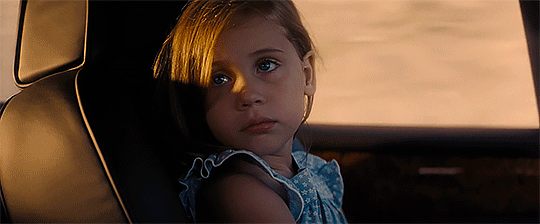
“I got one thing right.”
This is why Madeleine Swann is the love of his life. Because she *is* his life. She is the proof he can change his nature and finish his journey to find his ocean-eyed soul once again. All the cosmologic power of the divine in his hand, and James Bond lets it all go to save her. Which, by extension, saves himself.
No longer a murder. Now a man. The only thing he ever wanted to be.
#james bond#madeleine swann#craigbond#daniel craig#casino royale#quantum of solace#skyfall#spectre#no time to die#i did not intend to write this post today but it ended up just sort of spilling out onto the page#but now it is accomplished
174 notes
·
View notes
Text
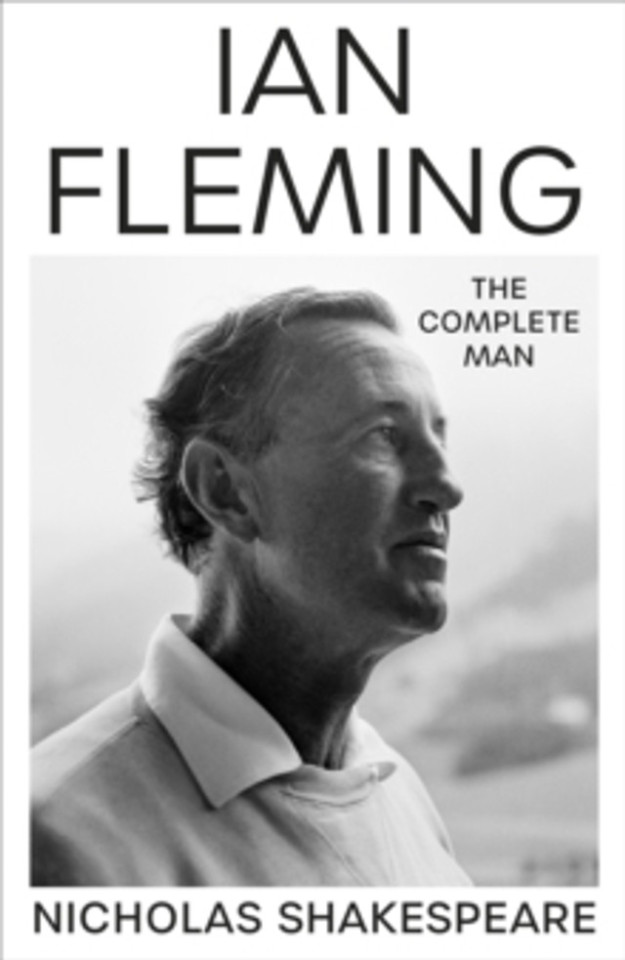
Nicholas Shakespeare’s elegant biography of the James Bond author Ian Fleming takes its subtitle from a journalist’s observation, quoted halfway through, that its subject was “for a moment of time, a complete man” while working for British naval intelligence in the second world war. Yet you can’t help read it as a promise to give the reader what was left out of previous biographies such as John Pearson’s crisp, more portable authorised life from 1966. And is there a claim, too, for the alpha male credentials of the man called “Flemingway” by his friend Noël Coward? Journalist, stockbroker, thriller writer and – like his famous creation – a playboy and 70-a-day smoker, who died of a heart attack in 1964 at the age of 56 after a plagiarism row over the origins of Thunderball, the ninth Bond novel.
After a dutiful account of how Fleming’s Scottish financier grandfather became a millionaire – later cutting Fleming and his brothers out of his will – Shakespeare gets going with his subject’s troubled boyhood in the shadow of his father’s death in the first world war. Family friends in Switzerland take his education in hand after hasty exits from Eton (hanky-panky with a woman) and Sandhurst (gonorrhoea). His exams aren’t good enough for the Foreign Office; an engagement to a Swiss lover ends amid maternal threats to cut off his allowance. He falls on his feet at Reuters – it was that kind of life – further honing his knack for a scoop at the Sunday Times, a handy source of contacts for his war work.
Testimony woven from diaries, papers and interviews gives the book a flavour of oral history. Shakespeare goes to great lengths – not least tracking down a 94-year-old veteran, the last surviving member of a covert commando unit that Fleming organised – to dispel the idea that Fleming’s service, occluded by state-sanctioned secrecy, was just “in-trays, out-trays and ashtrays”. The book’s first half puts the future author at the heart of military and journalistic history – a search for German weapons of mass destruction; the race to get an inside scoop on the Cambridge spies – as well as the bedroom shenanigans of the English well-to-do. (Shakespeare, who encourages us at one point to smile at the mention of a “germanely” named Nazi admiral, Assmann, shows his assumptions of his audience when he writes confidently of “that small, turn-of-the-century intellectual clique, the Souls”.)
Fleming may be “the man behind James Bond”, in the subtitle of Andrew Lycett’s 1995 biography, but Shakespeare’s project, you sense, is partly to say there’s more to him. Eager to prove Fleming’s interest beyond the reasons that will draw most of his readers to the book, he is almost comically insistent on the degree to which his subject was ahead of the curve. Not only might he have sparked the idea of creating the CIA – in a memo written when the US-UK special relationship was being forged – but he also came up with the idea of putting a Christmas tree from Oslo in Trafalgar Square.
As for the dozen Bond novels that poured out of Fleming after 1953’s Casino Royale – written in a month in his winter bolthole in Jamaica a year earlier – they were, in Shakespeare’s telling, essentially the literary expression of a midlife crisis accelerated by the encroachments of fatherhood and a faithless union as the third husband of Ann Charteris. They had got together with an affair that caused a high-society scandal during her previous marriage to the Daily Mail heir Esmond Harmsworth; she later cheated on Fleming with the Labour leader Hugh Gaitskell, who told him that the “sex, violence, alcohol” formula of the Bond novels was “to one who leads such a circumscribed life as I do, irresistible”.
Fleming, injecting the American dirt of Mickey Spillane’s Mike Hammer novels into the English thriller, launched 007 on what Shakespeare calls the “spam-munching gloom of Attlee’s Britain”, writing (Fleming told his publisher) in order to make “as much money... as possible” and to have “as much fun as I personally can”. Respectable sales rocketed when JFK took a shine to From Russia, with Love – and the movies were yet to come. While Fleming was self-deprecating – telling Raymond Chandler the Bond novels were “straight pillow fantasies of the bang-bang, kiss-kiss variety” – he was proud enough to greet the director of the first Bond movie, Dr No, by telling him: “So they’ve decided on you to fuck up my work.”
“Luck had to be accepted with a shrug or taken advantage of up to the hilt,” Bond thinks in Casino Royale; he sees luck “as a woman, to be softly wooed or brutally ravaged, never pandered to or pursued”. Squint enough and Fleming took some care to cast his main character in ironic light. Early in that novel, the reader gets a fly-on-the-wall thrill of watching fieldwork in action, with the scene of theatrical care Bond takes to ensure his hotel room isn’t being searched; but soon enough his French sidekick turns up to let Bond know his upstairs neighbours have been listening in to his every move.
In Shakespeare’s biography, the novels are mostly a source of supporting quotation – he doesn’t get bogged down in questions of what it means to read Bond now, confining himself to a remark on how his “cavalier treatment of women... carried the sexual climate of the Blitz into the austerity of the cold war, and was less modern perhaps than it was later cracked up to be”. And perhaps there’s no need for his defenders to overstate the case for Fleming’s novelistic subtlety. Bond has always been shaped by a collective amnesia that allows us to make him what we wish him to be at any given moment; when he parachuted into the Olympic opening ceremony with the queen, it was as the best of British, not as a connoisseur of (Fleming’s words) “the sweet tang of rape”.
The novels, in a way, are irrelevant to 007, but the course of history would surely have run otherwise had Fleming not had the foresight to change his protagonist’s name from the original “James Secretan” – Fleming’s typescript revision perhaps his most significant literary act.
Daily inspiration. Discover more photos at Just for Books…?
18 notes
·
View notes
Text

Casino Royale: A James Bond Novel by Ian Fleming, narrated by Richard, will be released on Google Play and Kobo on March 26, 2024.
Synopsis: James Bond Plays A Deadly Game Of Chance In Ian Fleming’s Legendary First 007 Novel.
“Le Chiffre” is a ruthless operative and the accountant for a soviet SMERSH cell in France, but he’s on the verge of disaster after gambling away his client’s money. Taking the last of his stash, he lures a dozen wealthy players to a high-stakes baccarat game, hoping to hustle his way whole.
The British Secret Service would like to see this red thorn plucked from the hide of Europe, and sends their best card sharp, James Bond, to bankrupt Le Chiffre for good.
With the cards running against him and SMERSH operatives threatening to kill him and his beautiful ally, Vesper Lynd, 007 needs his luck to turn before he wagers away their lives.
#richard armitage#ian fleming#casino royale: a james bond novel#new audiobook#audiobook#google play#kobo#march 2024#news
33 notes
·
View notes
Text
007 Fest 2023 - Headcanons!
Run out the guns, it's headcanon time! Prepare for barrage! (and my first post, so forgive me if I make a few mistakes, and it's a bit late due to my personal schedule)
Bond Headcanons
James Bond is not a codename.
Quite frankly, I've never subscribed to this theory. I've always believed that we jump to a slightly different universe with every actor switch. Each universe shares vaguely the same series of events, with certain commonalities. Such as…
Every film Bond has lost their Tracy, except (maybe) Connery and Craig.
Moore still visits his Tracy's grave, Dalton's was mentioned to have been married in LTK. Brosnan we never know flat out, but remember - "Or if you find forgiveness in the arms of those willing women, for all the dead ones you failed to protect…" Connery represents and interesting scenario. Diamonds are Forever can be read in two ways - either Bond is out Spectre-hunting after You Only Live Twice to catch the remains of what remains of Spectre, or he's on the warpath after Tracy died in On Her Majesty's Secret Service. For the sake of this theory, let's say that the latter scenario is canon.
Brosnan's Bond used to have unlimited spending money, but then Dench!M cut the funding, hence her nickname of evil queen of numbers
This is something that has some basis in the Fleming books. Bond in Casino Royale is allowed to spend exorbitant amounts of money on the Secret Service's tab - millions of francs that is. Despite the fact that in the 50s 1 pound meant 13 francs, this still constitutes a hefty amount. I remember reading that novel!Bond basically has an unlimited budget in a guidebook. I have a feeling this is similar in the movies - after all, I doubt even a RN commander's pension could afford the hundreds of thousands in monies Bond is bound to lose in the movies. Of course, in Brosnan!Bond's timeline, I have a feeling Dench!M ended up putting an end to that little scenario.
There was no Cuban Missile Crisis in the Fleming books.
Rather, Operation Thunderball was the "big nuclear scare that defined the Cold War". In the movies, it's largely kept under wraps, but in the book, it eventually goes public by the end of the story. Of course, the loss of two atomic bombs in the Caribbean may have convinced certain figures in the Soviet Union that keeping their nukes in such an area would be… disastrous to say the least. So with that in mind, they decided not to bite the bullet and kept Cuba nuke-free.
SMERSH was kept around specifically to counter the OO Section in the books.
SMERSH in real life was disassembled in 1946, whereupon the MGB took on its counter-intelligence duties before reformatting into the KGB in 1954. We know in later books, specifically The Man With the Golden Gun and Octopussy and the Living Daylights, that the KGB does exist in the Fleming books. However, considering how more proactive the British Secret Service is, especially with the OO section, I would hazard a guess that SMERSH was kept around specifically to combat them, at least until the KGB came into existence (which then absorbed it).
Brosnan's Lleweylln!Q did retire…
He took his fishing boat to Wales and lived out the rest of his days somewhere in the countryside where they only speak Welsh (a little something @emiliasilverova and I cooked up a few years ago)
Kincade is (or at least was) married to May Maxwell
For those of you who don't know, May Maxwell is Book!Bond's Scottish housekeeper. In between assignments, she and Kincade stay up in Skyfall, before Bond summons her to look after his flat until he returns. Sadly, perhaps the reason we don't see her in Craig!Bond's run is that she may have passed away at some point.
Blofeld was always a megalomaniac, but kept that under wraps... until Bond drove him over the edge
One major line of thinking I remember when I watched Tim Burton's Batman movies is that Batman is always just one step behind his villains in the crazy department, with his morals relatively intact. Conversely, we see Blofeld acting like an absolute machine in Thunderball (and all his appearances in the movies before YOLT), but when Bond foiled his plots, he slowly began to lose it. This gave way into him being more expressive, megalomanaical, and downright unconventional (biological warfare, suicide gardens, and diamond lasers) as time goes on. After all, how would YOU process your hundred-million-dollar master plans going up in smoke at the hands of a suave secret agent who always gets away with it?
Bond's favorite book is Treasure Island
John Gardner mentioned that Robert Louis Stevenson was Bond's favorite author. And with the latter writing a sea story that stars a young orphan named James, who gets involved in some epic swashbuckling adventures, it just feels right.
28 notes
·
View notes
Text


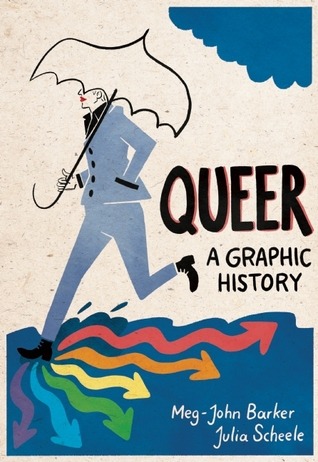
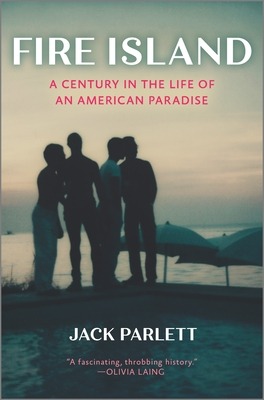
Nonfiction Thursday: LGBTQIA+ History Month
The LGBTQ+ History Book by DK Publishing
Exploring and explaining the most important ideas and events in LGBTQ+ history and culture, this book showcases the breadth of the LGBTQ+ experience. This diverse, global account explores the most important moments, movements, and phenomena, from the first known lesbian love poetry of Sappho to the Kinseys' modern sexuality studies, and features biographies of key figures from Anne Lister to Allen Ginsberg.
The LGBTQ+ History Book celebrates the victories and untold triumphs of LGBTQ+ people throughout history, such as the Stonewall Riots and first transgender surgeries, as well as commemorating moments of tragedy and persecution, from the Renaissance Italian “Night Police” to the 20th century “Don’t Ask Don’t Tell” policy. The book also includes major cultural cornerstones - the secret language of polari, Black and Latinx ballroom culture, and the many flags of the community - and the history of LGBTQ+ spaces, from 18th-century “molly houses” to modern “gayborhoods.”
The Gay Revolution by Lillian Faderman
The fight for gay and lesbian civil rights - the years of outrageous injustice, the early battles, the heart-breaking defeats, and the victories beyond the dreams of the gay rights pioneers - is the most important civil rights issue of the present day. In “the most comprehensive history to date of America’s gay-rights movement” (The Economist), Lillian Faderman tells this unfinished story through the dramatic accounts of passionate struggles with sweep, depth, and feeling.
The Gay Revolution begins in the 1950s, when gays and lesbians were criminals, psychiatrists saw them as mentally ill, churches saw them as sinners, and society victimized them with hatred. Against this dark backdrop, a few brave people began to fight back, paving the way for the revolutionary changes of the 1960s and beyond. Faderman discusses the protests in the 1960s; the counter reaction of the 1970s and early eighties; the decimated but united community during the AIDS epidemic; and the current hurdles for the right to marriage equality.
Queer: A Graphic History by Meg-John Barker & Jules Scheele
Activist-academic Meg John Barker and cartoonist Julia Scheele illuminate the histories of queer thought and LGBTQ+ action in this groundbreaking non-fiction graphic novel. A kaleidoscope of characters from the diverse worlds of pop-culture, film, activism and academia guide us on a journey through the ideas, people and events that have shaped 'queer theory'.
From identity politics and gender roles to privilege and exclusion, Queer explores how we came to view sex, gender and sexuality in the ways that we do; how these ideas get tangled up with our culture and our understanding of biology, psychology and sexology; and how these views have been disputed and challenged.
Along the way we look at key landmarks which shift our perspective of what's 'normal', such as Alfred Kinsey's view of sexuality as a spectrum between heterosexuality and homosexuality; Judith Butler's view of gendered behavior as a performance; the play Wicked, which reinterprets characters from The Wonderful Wizard of Oz; or moments in Casino Royale when we're invited to view James Bond with the kind of desiring gaze usually directed at female bodies in mainstream media.
Fire Island by Jack Parlett
Fire Island, a thin strip of beach off the Long Island coast, has long been a vital space in the queer history of America. Both utopian and exclusionary, healing and destructive, the island is a locus of contradictions, all of which coalesce against a stunning ocean backdrop.
Now, poet and scholar Jack Parlett tells the story of this iconic destination - its history, its meaning and its cultural significance - told through the lens of the artists and creators who sought refuge on its shores. Together, figures as divergent as Walt Whitman, Oscar Wilde, James Baldwin, Carson McCullers, Frank O'Hara, Patricia Highsmith and Jeremy O. Harris tell the story of a queer space in constant evolution.
Transporting, impeccably researched and gorgeously written, Fire Island is the definitive book on an iconic American destination and an essential contribution to queer history.
#lgbtqia history#nonfiction#nonfiction books#reading recommendations#reading recs#book recommendations#book recs#library books#tbr#tbr pile#to read#booklr#book tumblr#book blog#library blog#readers advisory
17 notes
·
View notes
Text

5 notes
·
View notes
Text

Let's dive into some trivia for Cutie Honey episode three: "Traps Set By the Red Axe."
Screenwriter: Susumu Takaku
Art Director: Mataharu Urata
Animation Director: Joji Kikuchi
Director: Osamu Kasai

Natsuko is pretending to practice zazen, a type of sitting meditation. It originates from the teachings of Buddha, and is meant to give insight into your true nature of being.
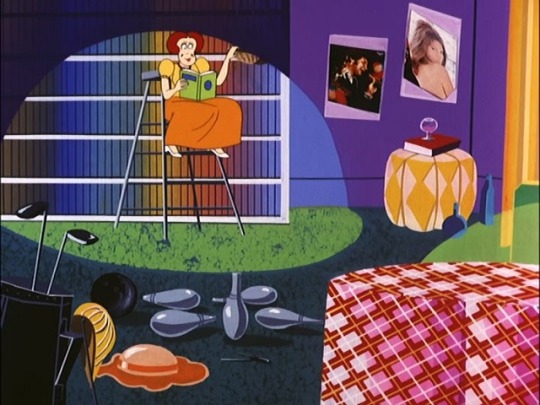
There’s a poster of singer Tom Jones hanging up in the teacher’s lounge. The “poster” is actually the Japanese vinyl cover of Tom Jones: Live in Las Vegas.

The shop featured in this episode, "Tihenny Jewelers", is a parody of the renowned real-life jewelry brand, Tiffany & Co. or Tiffany’s from New York City. Tiffany’s opened their first Japanese store in October 1972, a whole year before Cutie Honey premiered. This momentous event likely served as inspiration for this episode.
Although never addressed within the episode, production materials reveal Tomahawk Panther’s human alias is “Lydia.”

The shot of Seiji screaming the English word “help” is lifted straight from Casino Royale, the 1967 film adaptation of the first James Bond novel. In the film the character Evelyn Tremble (played by Peter Sellers, best known for playing Chief Inspector Clouseau in the Pink Panther films) is tortured by experiencing a series of psychedelic hallucinations. At one point he sees himself walking alongside a marching band while the word “help” is animated flying out of his mouth.
8 notes
·
View notes